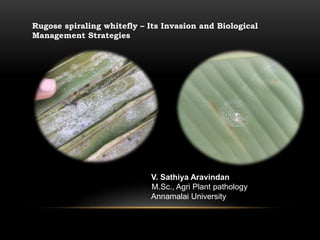
Rugose Whitefly Invasion and Biological Control
- 1. Rugose spiraling whitefly – Its Invasion and Biological Management Strategies V. Sathiya Aravindan M.Sc., Agri Plant pathology Annamalai University
- 2. This Rugose spiraling whitefly (Aleurodicus rugioperculatus) was first reported in Miami in the Florida region by Martin. This spiraling whitefly is a polyphagus pests (affecting wide range of hosts). Worldwide the rugose spiraling whitefly is known to affect more than 45 hosts including the plant species from the family Moraceae, Rutaceae, Arecaceae Musaceae and some other commercially important crops. In India spiraling whitefly is known to affect hosts from 21 families Commonly infected crops by rugose spiraling whitefly are Coconut, Arecanut, Papaya and Banana.
- 3. Prevalent all over the world but its prevalence is higher in India. Especially in South India. Severe in Tamilnadu and Kerala. Particularly it pose a severe threat to the farmers in Kongu belt of Tamilnadu including Coimbatore, Tirupur, Pollachi, Erode, Theni and Kanyakumari. Incidence of Sooty mold along with Rugose spiraling whitefly
- 4. Pest: Taxonomy: Domain: Eukarya Kingdom: Animalia Phylum: Arthropoda Class: Insecta Order: Hemiptera Suborder: Sternorrhyna Family: Aleyrodidae Genus: Aleurodicus Species: rugioperculatus
- 5. Epidemiology: Hot humid conditions are highly favorable for the pest development Pest control and Severity: Rugose spiraling belongs to the Order Hemiptera. In general the members of this order are known to produce the honeydew secretion. They are severe phloem feeders when they pierce their stylet into the phloem due to the high pressure they are tend to produce the honeydew secretion.
- 6. Rugose spiraling whitefly in Banana Rugose spiraling whitefly Honey dew secretion Thus the Aleurodicus rugioperculatus acts as a trichobiont (symbiotic relationship with other organism) the pest produce honeydew secretion which attracts the superficial fungi growth on the abaxial surface of the leaf most probably Capnodium sp complex Sooty mold due to Capnodium sp
- 7. This black superficial mat like growth drastically reducing the photosynthetic ability of the palms and thus resulting in the reduced nut quality and quantity. Management: For the control of sooty mold spraying of 5% of Maida solution (50g in 1 litre of water). Upon drying of the Maida solution the superficial fungal growth becomes flakes and fall off. Early monitoring of the palms should be recommended as they are more prone to the pest (Rugose spiraling whitefly easily penetrates the leaf area and pierce their stylet into the phloem) than the matured one. One of the most economically feasible methods of control of sooty mold is the Parasitoids. One of the most commonly employed parasitoid is Leiochrinus nilgirianus they are reared and mass multiplied and applied (clipped at the leaf) at the rate of 5beetles/palm. They have the specialized bristles containing legs which provide enough grips on the sooty mold laden leaves.
- 8. Image credits: A. Josephrajkumar, Chandrika Mohan, J. Poorani, Merin Babu, Daliyamol , Vinayaka Hegde , P. Chowdappa The above picture shows the various growth stages of Leiochrinus nilgrianus
- 9. Employing Encarsia guadeloupae a nymphal parasitoid effectively control the pest incidence they multiply inside the whitefly during their nymphal stages and parasitizes the entire system of the Rugose spiraling whitefly. Spraying water at very high pressure destroys the whitefly as well as ward off the sooty mold incidence. Setting up of Yellow sticky traps in the plantation areas considerably reducing the whitefly population. Several field studies revealed that application of the systemic insecticides makes the pest even more gregarious and resurgent one. So the application of any sort of insecticide should be strictly avoided. Encarsia guadeloupae
- 10. References: https://www.phytojournal.com/archives/2018/vol7issue5/PartQ/7-5- 165-544.pdf https://bit.ly/3LXjXGk https://krishi.icar.gov.in/jspui/bitstream/123456789/24859/1/leiochrini% 20paper.pdf https://link.springer.com/article/10.1007/s12600-017-0635-5